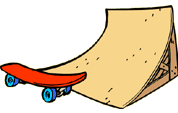SKATEBOARDING ACTIVITY CARD
Parts of the Body Worked

Upper & Lower Legs

Knees & Ankles

Have you ever seen someone skateboarding and wanted to try it?
Gear Up
Skateboards can be bought pre-assembled, or you can buy all of the pieces and put it together yourself. Pre-assembled boards are best for beginners, until you decide if skateboarding is really for you. If you are putting your own board together, you’ll need a deck (the board itself), grip tape for the top of the deck so your feet don’t slip, 2 trucks (the metal parts that are the axles of the wheels), 4 wheels, and 2 bearings per wheel (these keep the wheels spinning on the truck’s axle). Before each time you ride, make sure your trucks are tightened and your wheels are spinning properly. Don’t forget to wear a helmet, knee and elbow pads, and wrist guards. It’s important that your helmet is approved by one of the groups who test helmets to see which ones are the best: the Snell B-95 standard is best for skateboarding helmets. Non-slippery shoes are a good idea too, so you can have better control of your board.
Play it Safe
Before you ride, make sure you give your board a safety check to make sure everything is put together right. Always wear all of your protective gear including a helmet, knee and elbow pads, and wrist guards. If you do tricks with your board, you may also want to wear gloves to protect your hands from the pavement. If you’re just starting out, skate on a smooth, flat surface so you can practice keeping control of your board. And no matter how experienced you are — never hold on to the back of a moving vehicle! It’s best to skate out of the way of traffic and other people (skate parks are great places to skate). But if you are skating in streets near your house, be aware of cars and people around you, and stay out of their way. Also, once the sun sets, it’s a good idea to put up your board for the night, since skating in the dark can be dangerous.
How to Play
If you’re just starting out, follow these steps to develop your skateboarding skills. Put one foot on the board, toward the front, with the other on the ground. Push off the ground with your foot and put it on the rear of the board while you glide. Push again when you slow down. If you start going too fast, step off the board with your back foot. To turn, shift your weight to your back foot so that the front truck lifts off the ground and then move your body in the direction you want to go — the board will go with you.
If you want to find half pipes, vert ramps, and skate courses near you to practice your moves, look for a nearby skate park, designed to give skateboarders a great ride.
There are several different styles of skateboarding:
Street skating is skateboarding on streets, curbs, benches and handrails — anything involving common street objects. Street skating is best left to the pros though — it’s very dangerous.
Downhill skating is racing down big hills, usually on a longer skateboard called a longboard.
Freestyle skating is more artistic, involving a series of tricks and stunts.
Vert skating is skateboarding on mini-ramps and half pipes, which are U-shaped ramps.
Fun Facts
If you ride with your right foot forward, you have what’s called a goofy stance. If you ride with your left foot forward, you have a regular stance.
Professional skateboarder Tony Hawk is in the Guinness Book of World Records for being the only skateboarder to successfully do a “900.” That’s 2 1/2 rotations in the air from a ramp!
The first X Games competition was held in June 1995 in Rhode Island.
Related Links
- Page last reviewed: May 9, 2015
- Page last updated: May 9, 2015
- Content source:



 ShareCompartir
ShareCompartir